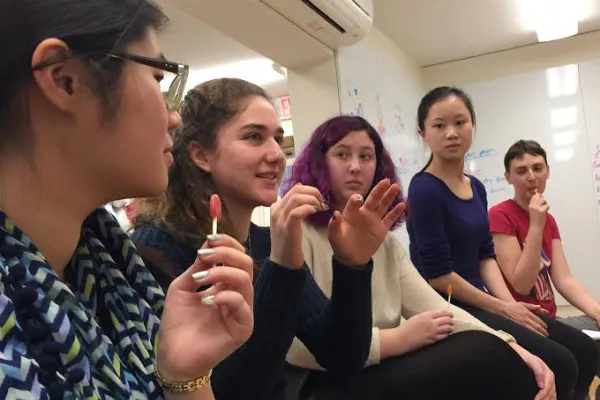Unleashing Creativity: An Interterm Introduction to Design Thinking
Research & Inquiry

Published January 26, 2016
When she first signed up for the Introduction to Design Thinking class offered during this year’s Interterm, Harleen Kaur ’16 wasn’t sure what to expect.
Kaur, who said she has taken mostly “analytical and quantitative courses” at Smith, was worried at first about how she would respond to a new learning strategy.
In the end, the design thinking class “challenged me to embrace mistakes and failures and to unleash my more creative side,” Kaur said, in a reflection she wrote for a classroom blog.
That meant thinking more “about the process of addressing a problem rather than finding the solution,” she added.
Kaur was one of 13 Smithies who enrolled in the Interterm class taught by Zaza Kabayadondo, co-director of Smith’s new Design Thinking Initiative. The class is part of a broader pilot project aimed at engaging students, faculty and staff in learning about design thinking as an approach to tackling problems systematically and creatively.
This semester, Kabayadondo will teach a (Critical) Design Thinking Studio course that will assign real-world design challenges using college departments and programs as “clients.”
Other Smith classes this semester will teach design thinking “mindsets” in disciplines ranging from psychology to mathematics.
In Kabayadondo’s Interterm class, students faced the challenge of adopting those mindsets in the span of a single week. The objectives of the class were to give students hands-on experience in framing problems with human-centered solutions.
Fortified by group discussions and readings, students were asked to design new teaching strategies in subjects ranging from composting to foreign languages. Working in small teams, they gathered information from observations and interviews with users in different learning sites to assess problems, held brainstorming sessions and created prototypes of solutions to demonstrate novel ideas to their classmates.
“A good prototype is meant to communicate how a concept or idea might look, feel and work once it is implemented,” Kabayadondo said.
The four prototypes were:
- a video game for improving language instruction,
- a portable desk to boost creativity in elementary school classrooms,
- a board game to encourage imaginative play between children and parents, and
- a lunchbox kit with lessons about composting.
Amanda Lavond ’18, who was on the team that created the portable classroom desk, said the compressed timeframe of the assignment actually helped her work process.
“I learned that giving myself a quick turnaround allows me to be more creative and also makes me less attached to a design,” Lavond wrote in her blog post. “I learned a lot about how the design thinking process flows and now have a much better understanding of when to be broad and when to be specific.”
Tam Nguyen ’16, who worked on the video game prototype, said the class encouraged her to think about design as “more of a storytelling experience” based on “looking at the perspectives of the users rather than the designer.”
“I think this is very helpful and applicable in many fields,” she added.
Even those students who had previously studied design said the Interterm class changed their thinking about how to frame problems and shape solutions.
Engineering major Bethany Claps ’16 said she “liked learning about the human-centered approach emphasized in this class, which allowed me to view the typical engineering design process through a friendlier, more approachable lens.”
The class met in the new design thinking studio in Capen Annex. During the final session, students gathered to share thoughts on what they’d learned. As each student finished speaking, she threw an imaginary ball to the next classmate wanting to comment.
Kabayadondo praised students for their readiness to embrace and apply design thinking concepts in such a short timespan.
“All of the projects focused on a different element of design thinking,” she said. “And you all did a really great job of working together.”
In her reflection, Jessica Innis ’17 said the Interterm class gave her the tools to begin applying design thinking to her other courses at Smith—and to “everyday life.”
“As someone who plans to run a startup in the not too far future, I realized that entrepreneurship in itself is design,” Innis said. “During this design thinking class, I really learned a lot about myself.”
Smith’s Design Thinking Initiative is hosting a design challenge on the theme of “Belonging,” Saturday, April 2, from 10 a.m. to 4 p.m. in Capen Annex. Students are invited to sign up in teams for a hands-on experience with problem framing by contacting Kabayadondo at zkabayadondo@smith.edu.
For more information about Smith’s Design Thinking initiative, visit http://smithiesdesign.com.
Students in the Introduction to Design Thinking Interterm class discuss learning strategies.